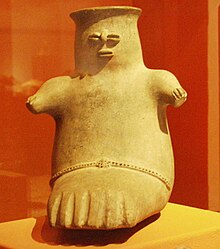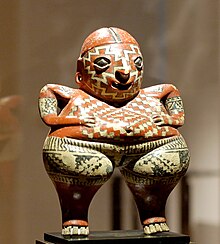Chupícuaro
| Name: | Chupícuaro |
| Location | Acámbaro, Guanajuato |
| Coordinates | 20°01′20″N 100°35′29″W / 20.02222°N 100.59139°W / 20.02222; -100.59139Coordinates: 20°01′20″N 100°35′29″W / 20.02222°N 100.59139°W / 20.02222; -100.59139 |
| Culture | Chichimec - Toltec |
| Period | Preclassical Mesoamercian Period |
| Language | Purépecha language |
| INAH Official Page | Not available |
Chupícuaro is an important prehispanic archeological site from the late preclassical or formative period. The culture that takes its
name from the site dates to 400 BC to 200 AD, or alternatively 500 BC to 300 AD.[1], although some academics suggest an origin as early as 800 BC.[2]
Although often included with the cultures of the Mexican West, Chupícuaro is both close to the Valley of Mexico and the northern edge of Meso-America. Information on the epynomous site, composed of several burial grounds, remains fragmentary, since most of it was flooded when the Presa Solis dam was built in the 1940s. A INAH excavation was able to salvage a little before that happened.[2] Other excavations took place beginning in 1998,[3] by the CEMCA, CNRS and l'INAH, and also contributed to knowledge of Chupicuaro culture.

Chupicaro figurine, Michoacan
.
On the northern border of Mesoamerica, west of the Mexican Plateau, just seven kilometers from Acámbaro, in Guanajuato State, México, it lies in hills near the Lerma River and its tributary the Coroneo or Tiger River.[2]
Contents
1 Etymology
2 History
3 Site
4 Chupícuaro culture
5 Regional cultures
6 Late Preclassical or Formative
7 Ceramic
8 Burials
9 References
10 Bibliography
11 External links
Etymology
The name Chupícuaro can be translated as blue place.[4] The name derives from the Purépecha language word "chupicua", a name for the "Ipomoea" plant, used for blue dye, and the term "ro", place.
History
This prehispanic archaeological site is located on the banks of the Lerma River, between the present-day cities of Acámbaro and Tarandacuao in the state of Guanajuato, Mexico. Little is known about the history of this site. The first explorations took place in 1946 and uncovered pottery objects and tombs. The site is currently below water because of the dam, although the surrounding area is still being explored.[5]
Chichimeca nomadic groups (Guamares and Guachichil) arrived from the current San Luis Potosí state.[6]
These groups settled in a large village of huts built over platforms coated with mud and stone. They grew corn, beans and squash on the banks of the Lerma River and its tributaries. Based on the existence of metals and stone molcajetes used to grind corn, they probably planted chili and tomatoes. It is also known they were hunters-fishers-gathers.[2]
According to several authors, this settlement developed between 500 BCE and 300 CE. The first inhabitants of this area were hunter-gatherers who lived along the river and eventually developed agricultural knowledge.[2]
In 2013 the level of the water behind the dam in Chupicuaro was lowered for a couple of days. Archeologists brought the towers from the old church to the town of Nuevo Chupicuaro in Guanajuato — the town founded in 1946 after the townspeople of the original town of Chupicuaro had to move out following the construction of the dam.
Site

Chupicuaro statuette at the Louvre
From type evidence, its development has been established between 500 BCE and 300 CE, although some scientists suggest an older development, as far back as 800 BCE.[2]
Ibarrilla, an unexcavated site in Leon, Guanajuato, is seen as part of the Chupicuaro complex. This archaeological site is potentially one of the most extensive and important of the country according to one author.[who?] There are thought to be more than a dozen pyramids built on an oval basement. Only one has been partially explored; various flint stone objects, figurines and pottery were found.
The rest of the structures remain to be explored. There are tombs, altars and other scattered remains in an estimated 500 m2 area.[6]
Chupícuaro culture
This culture is important due to its influence in the area. It may have spread to what is now the southern United States, circa 500 BCE. There are theories that the first inhabitants of Guanajuato belonged to this culture.[6]
Ceramics of this culture pre-date the classical Mesoamerican period, and include angular figurines with geometric shapes. The Acámbaro museum exhibits pieces from the Purépecha, Mazahua, and Otomi cultures.[6]
Apparently the Chupícuaro culture developed in a vast territory, or it was defined as Chupícuaro style or tradition (Beatriz Braniff) in, Guanajuato, Michoacán, Guerrero, Mexico State, Hidalgo, Colima, Nayarit, Querétaro and Zacatecas. It is estimated that Chupícuaro facilitated the northward expansion of Mesoamerican elements (cultural roots of western Mexico and perhaps Northwest, comparable with the Olmec culture throughout Mesoamerica (Jiménez Moreno, 1959: 1043).)
Chupícuaro had an important cultural development and expansion of its style in distant areas from the diffusing center and influenced ceramic traditions, which lasted until the end of the classical period, and even into the Postclassical, as seen in Purépecha Michoacán ceramic.[2]
At the end of 1985, at the first prehispanic societies meeting in relation to the Chupícuaro culture, it was noted, that Chupícuaro tradition ceramics manufacturing groups, should be considered part of Mesoamerican stratified societies, with a definite political and territorial structure, rather than as isolated village societies, lacking ceremonial centers and architecture. From that first impulse, subsequent social groups presented their own cultural expressions at a regional level in the Mesoamerican context.(Crespo, et al., 1988:259).
Regional cultures
The Acámbaro region had five Prehispanic cultures:
- Chupícuaro – Late Preclassical - 800 BCE to 200 CE.
Los Morales - Late Preclassical - 400 BCE to 250 CE.
Teotihuacán - Classical Period - 200 CE to 900 CE.
Toltec – Early Postclassical - 900 CE to 1200 CE.
Purépecha – Late Postclassical - 1200 CE to 1525 CE.
Source: Archaeology Hall, Acámbaro Local Museum, Guanajuato, 2001.[2]
Late Preclassical or Formative
The decline of Olmec culture at the beginning of the Late Preclassical period (400 BCE - 150 CE) marked a period of cultural diversification and assimilation of Olmec elements into cultural systems that was the origin of several of the most important Mesoamerican traditions. However, Cuicuilco in the south of the Valley of Mexico, and the Chupícuaro, are the most important. The first became the largest city in Mesoamerica and the main ceremonial center of the Valley of Mexico; it maintained relations with Chupícuaro. The decline of Cuicuilco paralleled the emergence of Teotihuacán, and consumed with the eruption of the Xitle volcano circa 150 CE, which led to migration north from the Valley of Mexico. Chupícuaro culture is known for its ceramics, of which remnants have been found in a wide area located in the Bajío and the lake basin.
Ceramic
Chupícuaro was a major ceramic center, recognized as one of the best in Mesoamerica for the fine ceramic finishing and decoration, which were developed in multiple shapes and colors, some with geometrical drawings. The motifs were deities, maternity, breastfeeding, people and their ornaments, animals and plants.
Ceramics included multiple monochromatic forms and a variety of three-color polychrome (red, beige and black) with pyramidal geometrical drawings or zig-zags. Clay figurines used “pastillaje” techniques and made hollow figures. Shell, bone and stone were used.[2]
From a study of ceramic styles, the clothing used is inferred, they painted their faces and bodies, wore sandals, truss, necklaces, earflaps, and earrings. Women wore elaborate hairstyles.[2]
Burials
Chupícuaro inhabitants practiced a cult of the dead characterized by tombs where they placed trophy skulls, obsidian arrowheads, metates, figurines, earflaps, shell ornaments, necklaces and beads, bone artifacts and musical instruments. These were all found during excavations around 1950.
The many burials and offerings provide knowledge of the way of life of the ancient Chupícuaro inhabitants. They were farmers who lived in huts built from perishable materials forming a good extended rural village, built low platforms with clay floors, ,sometimes grouped together, over which their houses were built. They harvested corn, beans and pumpkin.(pineapple CHAN, 1967: 263).
References
^ Beatriz de la Fuente, L'art précolombien en Mésoamérique (Precolombian Art in Meso America), Hazan, 2003, p. 124
^ abcdefghij "Boletín de Cultura Chupícuaro" [Chuícuaro Cultural Bulletin=] (PDF) (in Spanish). Guanajuato: Local Acámbaro Museum. Archived from the original (PDF) on 17 July 2011. Retrieved 26 October 2010..mw-parser-output cite.citation{font-style:inherit}.mw-parser-output .citation q{quotes:"""""""'""'"}.mw-parser-output .citation .cs1-lock-free a{background:url("//upload.wikimedia.org/wikipedia/commons/thumb/6/65/Lock-green.svg/9px-Lock-green.svg.png")no-repeat;background-position:right .1em center}.mw-parser-output .citation .cs1-lock-limited a,.mw-parser-output .citation .cs1-lock-registration a{background:url("//upload.wikimedia.org/wikipedia/commons/thumb/d/d6/Lock-gray-alt-2.svg/9px-Lock-gray-alt-2.svg.png")no-repeat;background-position:right .1em center}.mw-parser-output .citation .cs1-lock-subscription a{background:url("//upload.wikimedia.org/wikipedia/commons/thumb/a/aa/Lock-red-alt-2.svg/9px-Lock-red-alt-2.svg.png")no-repeat;background-position:right .1em center}.mw-parser-output .cs1-subscription,.mw-parser-output .cs1-registration{color:#555}.mw-parser-output .cs1-subscription span,.mw-parser-output .cs1-registration span{border-bottom:1px dotted;cursor:help}.mw-parser-output .cs1-ws-icon a{background:url("//upload.wikimedia.org/wikipedia/commons/thumb/4/4c/Wikisource-logo.svg/12px-Wikisource-logo.svg.png")no-repeat;background-position:right .1em center}.mw-parser-output code.cs1-code{color:inherit;background:inherit;border:inherit;padding:inherit}.mw-parser-output .cs1-hidden-error{display:none;font-size:100%}.mw-parser-output .cs1-visible-error{font-size:100%}.mw-parser-output .cs1-maint{display:none;color:#33aa33;margin-left:0.3em}.mw-parser-output .cs1-subscription,.mw-parser-output .cs1-registration,.mw-parser-output .cs1-format{font-size:95%}.mw-parser-output .cs1-kern-left,.mw-parser-output .cs1-kern-wl-left{padding-left:0.2em}.mw-parser-output .cs1-kern-right,.mw-parser-output .cs1-kern-wl-right{padding-right:0.2em}
^ (in Spanish)"México - Chupícuaro". diplomatie.gouv.fr. Ministère des Affaires étrangères (France). Retrieved 21 February 2014.
^ "Diccionario Breve de Mexicanismos" [Brief Mexican slang dictionary] (in Spanish). Academia Mexicana de la Lengua. Retrieved 9 May 2008.
^ "Apuntes de Arqueología - México - Chupícuaro" [Archaeology Notes - México - Chupícuaro] (in Spanish). Ministerio de Asuntos Exteriores francés. Retrieved 9 May 2008.
^ abcd "Historia prehispánica" [Prehispanic History]. León-Gto. Retrieved 29 October 2010.
Bibliography
- Ofrendas Funerarias de Chupícuaro Guanajuato. Dolores Flores. INAH. 1992. (Spanish)
- Estudios Arqueológicos en el Río de la Laja, Guanajuato. Beatriz Braniff de Torres. INAH. 1975. (Spanish)
- Síntesis de la Historia Pre-tolteca de Meso América. Wigberto Jiménez Moreno. CIAM. 1959. (Spanish)
- Una visión del México Prehispánico. Román Piña Chán. UNAM. 1967. (Spanish)
- La arqueología en Guanajuato. Crespo, Ana María. INAH. 1988. (Spanish)
External links
- Acámbaro Municipality, Official Web Page (Spanish)
- Guanajuato State Government, web page on Acámbaro (Spanish)
- Unknown Mexico Magazine, Acámbaro